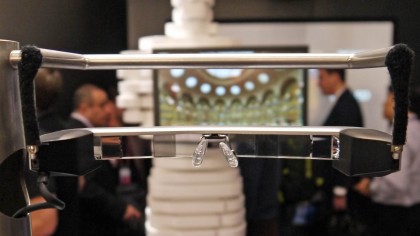Early Verdict
Epson has refined its eyewear range, offering a lighter and better-looking package. It's still not clear, however, whether the glasses will appeal to consumers, business user or both.
Pros
- +
Good-looking design
- +
Lightweight
- +
Decent processing power
Cons
- -
App ecosystem still light
- -
Augmented reality out of favor
Why you can trust TechRadar
With Google Glass taking a break from perching on the nose of tech enthusiasts, there is an opening for a new smart spectacle upstart and Epson has its eyes on the prize.
The Epson Moverio BT-300 is the third iteration of the company's smart eyeglass lineup. It comes with a new lightweight form factor - 20% lighter than the BT-200 range - that has a 'Google' feel and is equipped with an OLED display, which projects an image in front of the eyes that feels around 80 inches in size.
All of this is powered by a Intel Atom X5 processor and Android 5.1.

Using this processor means that the Epson Moverio BT-300 is able to render 3D a lot better and recognise more objects in its peripheral vision. All of this makes for more realistic AR.
Look and feel
In my time with the device, I found that the augmented reality functionality was decent. There was a couple of demos we tried - once was of a painting that magically came to life as we looked at it, and another was a simulation of controlling a drone.
The drone part was really interesting - fake piloting a drone and getting to see what it was seeing was pretty cool, as was the flipping between first and third person.

The glasses were pretty comfortable, too. They are definitely light and compared to the previous iterations of Epson's glasses, they are super thin and actually don't look 'that' stupid.
Sign up for breaking news, reviews, opinion, top tech deals, and more.
They are very Google Glass, though. Epson has definitely taken design ideas from Google, while adding its own industrial twist, before the search giant decided to put its Glass production on hold.
Battery life
Battery life on the eyewear is a cool six hours which is plenty of time, given that you won't want to wear the Moverios all of the time.

The problem Epson has is its reliance on third-party augmented app makers. It's a big problem with AR in general. It may have been around longer than the current virtual reality headsets, but there's not been much of a demand for software.
This is a shame, because when it works well - map overlays for cyclists, for example - augmented reality shines but there's just not enough reason to get AR glasses at the moment.
Epson hopes to remedy this with the inclusion of some business-focused AR ideas, including virtual instruction manuals.
There's also camera functionality on board. So if you get bored with augmented the world around you, you can snap away at unsuspecting bystanders - a feature that caused quite a bit of controversy when it was introduced in Google Glass.

Early verdict
It's three times the charm for Epson. It has managed to create some smart eyewear that can not only match Google Glass in the looks department, but functionality wise as well.
The issue is: with Google seemingly out of the augmented reality game, is there still an appetite for this technology? Epson hopes so, but I am still not so sure.

Marc Chacksfield is the Editor In Chief, Shortlist.com at DC Thomson. He started out life as a movie writer for numerous (now defunct) magazines and soon found himself online - editing a gaggle of gadget sites, including TechRadar, Digital Camera World and Tom's Guide UK. At Shortlist you'll find him mostly writing about movies and tech, so no change there then.
What is a hands on review?
Hands on reviews' are a journalist's first impressions of a piece of kit based on spending some time with it. It may be just a few moments, or a few hours. The important thing is we have been able to play with it ourselves and can give you some sense of what it's like to use, even if it's only an embryonic view. For more information, see TechRadar's Reviews Guarantee.
